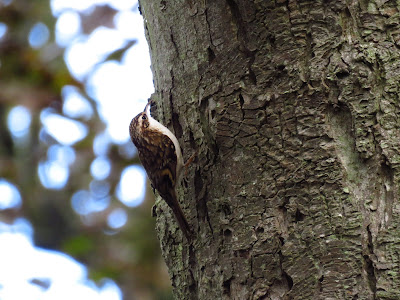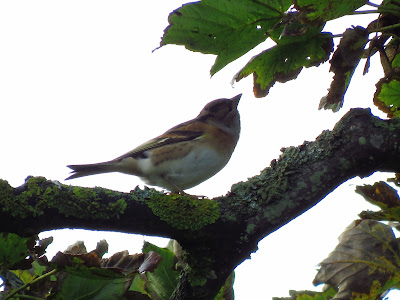
I decided to do the final stage of Migrants Way today to take advantage of the low tide around lunchtime. After a short, light early shower, the day turned up fine, with long sunny spells and light wind.

Filey Brigg
Walk information
Massimino, D., Woodward, I.D., Hammond, M.J., Harris, S.J., Leech, D.I., Noble, D.G., Walker, R.H., Barimore, C., Dadam, D., Eglington, S.M., Marchant, J.H., Sullivan, M.J.P., Baillie, S.R. & Robinson, R.A. (2019) BirdTrends 2019: trends in numbers, breeding success and survival for UK breeding birds. BTO Research Report 722. BTO, Thetford. www.bto.org/birdtrends
I start by walking around Glen Gardens, as the oaks and sycamores may offer refuge to tired migrants coming off from the sea. However, the only bird of note is a Great Spotted Woodpecker, a species that hasn't been common during the walk. I carry on through Crescent Gardens, noting a few Pied Wagtails. The songs of Starlings from the rooftops, Robins from the gardens and the whistling of a Herring Gull fledgling begging to a parent is the background soundscape at Filey town.
The view towards Flamborough Head with showery clouds.
I take the steep steps up Church ravine, listening and searching for migrant birds. I'm surprised by a Treecreeper, the first time I see one at Filey. A group of Blackbirds feed on a hawthorn. A flock of birds feeding on the high crowns of sycamores (on aphids?) on the ravine turn up to be Brambling, I have lovely views of a male.
Treecreeper.
Male Brambling.
Brambling.
At the country park Oystercatchers, Magpies and Black-headed gulls feed on the grass.Oystercatchers.
A flock of Greenfinches feed on rose hips at the top of the country park.
A Redwing by Carr Naze pond appears a bit dazed, maybe just in from crossing the North Sea.
This Black-headed gull had a beautiful pink tinge on its chest, hard to capture on the photo.
A Whinchat gave great views while sitting on fence posts on Rocket Pole field.
Meadow Pipit
I walk on the path atop Carr Naze, and learn from an information panel of the location of an excavated Roman signal station and the fact that Carr Naze was much wider, estimated at 200 m wide, in Roman times. Carr Naze, the 'head' of the Narwhal shape of the peninsula, is made of soft, glacial till, its base is an inclined platform of Jurassic sandstone from the Birdsall grit formation, rich in marine fossils. This layer of hard rock slows down the erosion of the till on top.
I take the narrow and steep path down to the beach. I come across several beetles crossing the path. They are quite distinctive, but I had never seen them before. It didn't take long to identify them as Galeruca tanaceti, a leaf beetle of open grassland and heathland, which appears as localised in its distribution. Larvae and adults feed on knapweed, yarrow and other common species, the adults emerging in the autumn.

Female Galeruca tanaceti.
As I reach the beach, I notice a Blackcap on the cliff rocks. It drinks dew from the stems on a thrift, and hunts some insects, appearing quite nonchalant about the fact that is very exposed. It looks like it is another recently arrived migrant.
There is so little wind that it is very easy to walk to the tip of the Brigg. In rough days the waves break over it. A Great Crested Grebe is fishing in the bay. A Cormorant has got a large, long fish (an eel?), which slips out of its bill, young Herring Gulls are being very watchful of its activities. A Shag and some Cormorants dry their wings on the rocks.
Filey Brigg SSSI for geological and ornithological interest, for the numbers of passage and winter Purple Sandpipers. A single Purple Sandpiper is about, with three colour ringed Knot and a Dunlin. I have my lunch on the rocks of the Brigg, overlooking the bay.
Looking back to Filey Bay from the Brigg.
Filey Brigg.
The moment a fish slips from the Cormorant's bill. Fortunately, it got it again before the gulls could get at it.
Shag.
Cormorant.
Knot
Colour-ringed Knot. These have been ringed by the Filey Bird Observatory. Contact them if you visit and spot any!
Rock Pipit.
Rock Pipit.

Featured bird: Spotted Flycatcher
I came across a Spotted Flycatcher at the top scrub of the country park, feeding on a sunny glade. An understated bird, a 'little brown job' you could say, but they Spotted Flycatcher is a very pleasantly proportioned bird, with large dark eyes and wide bill, long, thin wings and, a spotty forehead and chest. Its upright, alert posture, and habit to hunt from a prominent perch, returning to it after sallying to catch an insect, make it quite distinctive even at long range. Only a few decades ago, Spotted Flycatchers were common summer visitors in East Yorkshire, often breeding in parks, cemeteries and gardens, including at Filey. However, between 1967 and 2016 populations declined a whooping 87%, although the declining trend appears to have somewhat stabilised in the last couple of decades. Nowadays, breeding pairs in East Yorkshire are scarce, and you should count yourself lucky to see migrating individuals. Spotted Flycatchers are now red-listed in the UK, although there has been declines in Europe as a whole too. The reasons behind the decline are not fully understood, there seem to be poor 1st year individual survival, but this being a long-distant migrant bird - wintering in Sub-Saharan Africa - it is possible that changes in survival during migration or in the wintering grounds could have been responsible for the declines.
Spotted Flycatcher trend (2017 is used as a benchmark with 100 value). See More Information for citation.
8 km circular. Start Filey beach promenade (free parking) TA119802. Finish at Filey Brigg. Public toilets at the beach promenade by Glen Gardens, Church Ravine and country park (summer season). Beach accessible at various places at Filey town, from the country park at Church Ravine, Wool Dale and Carr Naze steps. The steps and path up to Carr Naze is of difficult access and slippery when wet. Check tides if planning to walk to the Brigg on the beach as the footpath is not exposed at high tide.
More information
Filey Bird Observatory. website.
























No comments:
Post a Comment